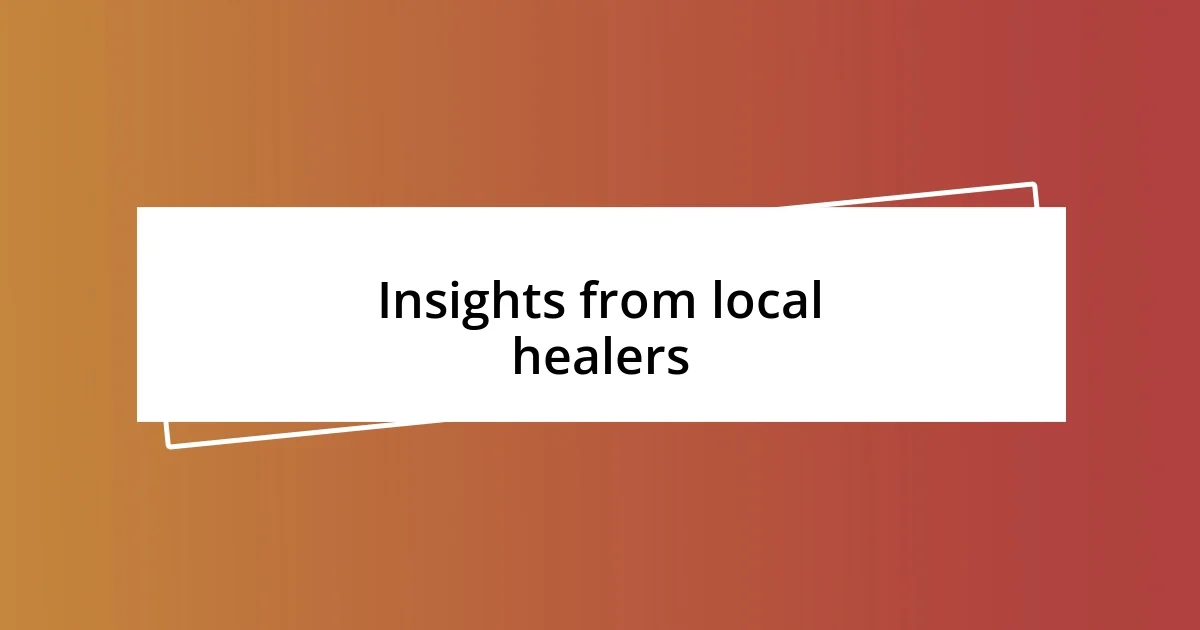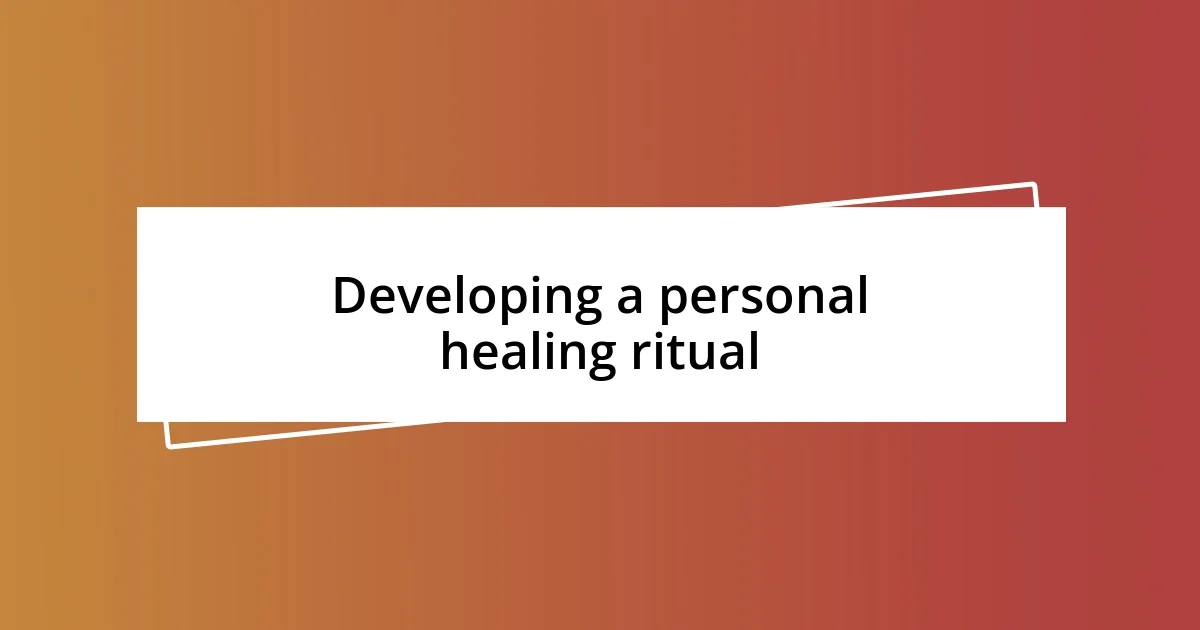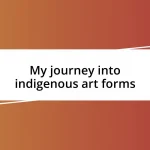Key takeaways:
- Traditional healing practices focus on holistic well-being, addressing the mind, body, and spirit while fostering community connections and cultural preservation.
- Engagement with local healers reveals the significance of intention, community bonds, and the relationship with nature in the healing process.
- Integrating traditional healing with modern medicine can create a more comprehensive and personalized approach to health, enhancing the overall healing experience.

Understanding traditional healing practices
Traditional healing practices are fascinating because they draw upon deep cultural roots and age-old wisdom. For me, engaging with these methods often feels like stepping into a vibrant tapestry woven with stories and traditions passed from one generation to the next. Have you ever wondered how the intentions behind these practices resonate with the collective experiences of those who came before us?
I recall a time when I visited a herbalist in a small village. The very air was thick with the scent of dried herbs, and I could feel the history in every word she spoke about the plants she used. It was an experience that opened my eyes to the profound connection between nature and healing, reminding me of the countless individuals who have walked this path before, trusting in the earth’s offerings.
Understanding these practices also involves looking at the holistic approach they embody. Rather than simply treating symptoms, traditional healing often addresses the whole person—mind, body, and spirit. Don’t you find it intriguing how these methods can foster a sense of community and belonging, reminding us that healing isn’t just a personal journey, but a shared human experience?

Benefits of traditional healing methods
The benefits of traditional healing methods often extend far beyond physical ailments. Personally, I’ve experienced a sense of calm and clarity during these practices that modern medicine sometimes overlooks. I remember attending a community ceremony where traditional songs filled the air; it wasn’t just about healing my body but also about revitalizing my spirit and connecting with others who shared similar struggles.
Some benefits of traditional healing methods include:
– Holistic Approach: They address emotional and spiritual well-being, fostering overall health.
– Cultural Connection: Engaging with these practices helps preserve cultural traditions and strengthens community bonds.
– Natural Remedies: Many treatments utilize local herbs and plants, making them eco-friendly and sustainable.
– Empowerment: Individuals often feel a greater sense of control over their health by participating in their healing process.
– Personal Relationships: The intimate nature of these practices can create strong bonds between healers and patients, rooted in trust and understanding.
These elements contribute to a richer, more inclusive experience in the journey of healing.

Insights from local healers
As I delved into the world of local healers, I found that each one brought their unique perspective and methods shaped by tradition. A healer I met in the mountains spoke passionately about the power of intention, emphasizing how a person’s mindset can significantly influence the healing process. This idea resonated deeply with me; after all, our beliefs can shape our experiences in profound ways.
During another visit, a wise elder shared stories illustrating the deep relationships within the community. He described how, in his village, healing practices function as a tapestry that connects people. This sense of connection is palpable, and I remember feeling a rush of warmth as common struggles and triumphs were woven into the fabric of our conversation. It struck me how these healers become beacons of hope, providing not just remedies but also emotional and social support.
It’s also worth noting how local healers often emphasize the importance of nature in their practices. One healer invited me to join her in foraging for herbs, explaining not just their medicinal properties, but also their stories. She described each plant’s role in the natural ecosystem, and I felt an awakening—a realization of how intertwined our well-being is with the environment. This connection to the earth, through healing, fosters a sense of belonging that transcends individual needs.
| Healer’s Approach | Key Insight |
|---|---|
| Mountain Healer | The mind’s intention plays a crucial role in healing. |
| Elder Healer | Community bonds are essential for holistic well-being. |
| Herbal Forager | Nature is integral to both healing and personal connection. |

Comparing traditional and modern medicine
When I first started exploring modern medicine, I was struck by its efficiency. Doctors often focus intensely on diagnosing and treating specific ailments with cutting-edge technology. However, there was a moment during a check-up when I felt a disconnect, almost like I was just another number in the system. I couldn’t help but wonder, what about the emotional and spiritual aspects of health?
On the other hand, traditional healing practices resonate with me because they emphasize a comprehensive approach. I recall a session with a traditional healer who would sit down with me for an hour, often asking not just about my physical symptoms, but how I was feeling emotionally and spiritually. This level of attention fostered a sense of belonging and understanding that I sometimes miss in modern medical settings. I began to see myself as part of a larger narrative rather than an isolated problem to be fixed.
It’s interesting to think about how these two systems can complement each other. I personally believe that integrating the precision of modern medicine with the holistic sensibility of traditional practices might lead to a richer healing experience. Imagine combining the best of both worlds, where one can receive not just a prescription but also a nurturing touch that considers the mind, body, and soul. Wouldn’t that be a more comprehensive way to approach health?

Developing a personal healing ritual
Creating a personal healing ritual has been one of the most rewarding experiences for me. I’ve learned that it doesn’t have to be elaborate; sometimes, simplicity is key. For instance, I started a morning practice where I light a candle, set my intentions for the day, and take a few moments to breathe deeply. This small act creates a space for mindfulness that helps me navigate the chaos of daily life.
One evening, after a particularly challenging week, I decided to incorporate elements of nature into my routine. I went outside and collected a few stones and leaves that caught my eye. As I arranged them on my desk, I began to reflect on each piece—what it represented to me and how it connected to my emotions. That connection between the physical and emotional was profound; it was as if nature itself whispered the healing I needed at that moment. Do you ever feel that connection with nature? For me, it’s a powerful reminder that healing can be found in the world around us.
As I’ve developed this ritual, I’ve realized the importance of consistency. I try to dedicate at least a few minutes each evening for this practice, allowing it to evolve as I do. It’s fascinating how personal rituals can shift over time, adapting to what we need at different stages of our lives. Have you ever thought about how your own practices could change with you? Creating a personal healing ritual is not about perfection; it’s about finding what resonates with you, making it unique, and allowing it to grow alongside your journey.

Recommendations for exploring traditional practices
When considering traditional healing practices, it’s essential to approach them with an open heart and mind. I remember attending a workshop on herbal remedies, where the atmosphere was filled with the earthy scents of dried plants and flowers. It felt like stepping into a time capsule, filled with ancient wisdom. Engaging with practitioners who have deep-rooted knowledge can enrich your understanding; have you ever felt that rush of excitement when learning something new in a hands-on way?
I also recommend taking the time to reflect on your own cultural heritage. Exploring the healing practices of my ancestors connected me to my roots in a way I hadn’t anticipated. I found it fascinating to uncover old recipes and rituals that had been passed down through generations. Could there be a healing tradition in your family that you’ve yet to discover? It’s worth delving into; these discoveries can create a profound sense of identity and purpose in your own healing journey.
Lastly, don’t hesitate to combine elements that resonate with you from different traditions. One of my most enlightening experiences was visiting a local ayurvedic center while learning about acupuncture techniques. The way these practices intertwined brought a fresh perspective to my approach to wellness. Have you ever tried something new that just clicked for you? Embracing this blend can enhance your understanding and may ultimately lead to a more personalized and effective path to healing.














